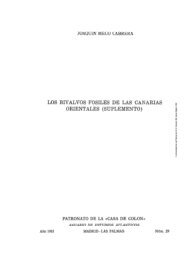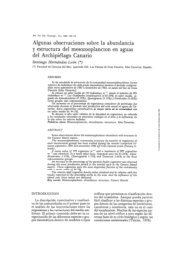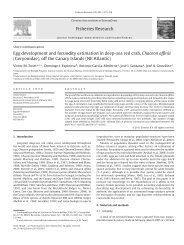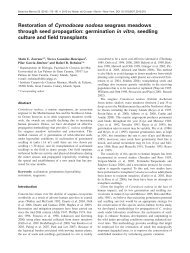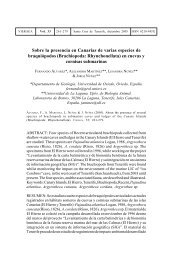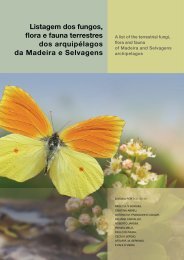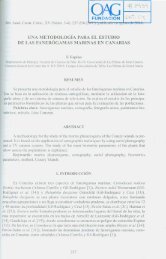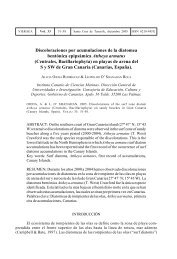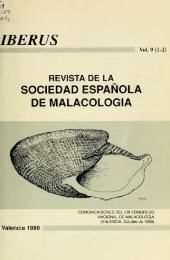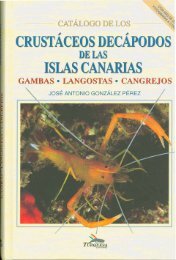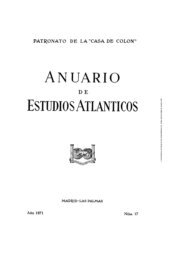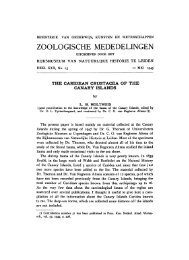A REVIEW OF GERARDIIDAE (ANTHOZOA: ZOANTHARIA ... - redmic
A REVIEW OF GERARDIIDAE (ANTHOZOA: ZOANTHARIA ... - redmic
A REVIEW OF GERARDIIDAE (ANTHOZOA: ZOANTHARIA ... - redmic
You also want an ePaper? Increase the reach of your titles
YUMPU automatically turns print PDFs into web optimized ePapers that Google loves.
column wall; the endoderm associated to them can reach to 120 J.lm thick. W,<br />
observed unilobulated filaments. All the macrocnemes bear gonads in the s e Only<br />
ied (Fig. 4c). pec1rnen<br />
Cnidom: A complete survey of the cnidom (measurements catego'<br />
. . . , ' nes a d<br />
ment) of the matenal from the two Medlterranean 10calItIes studied is in Tabl n pl<br />
Fig, 3), We noticed one category of spirocysts and several categories of the e<br />
II<br />
(see<br />
. h . f 11' , oth cysts eqUlpment: t ree categones o e Iptlcal, so me of them ovoid<br />
el'<br />
.<br />
ne<br />
mastigophores); one category is the special spirulae only present in some g~Osplrulae<br />
th'd I S as the present genus. T'wo pemcI '11' I ( p-mastlgophores) . categories: one cate ups of<br />
tlca<br />
. l<br />
to some OVOI<br />
'd'<br />
pemcI<br />
'11'A d . gorYofel<br />
1 an one category of ellIptical big penicilli E es .<br />
mon In<br />
'h<br />
t especia<br />
' 1<br />
areas o<br />
f<br />
t<br />
h<br />
e en<br />
d<br />
oderm of the wall (see description above),<br />
peclally Co<br />
Table n. Gerardia savaglia. Survey of the cnidom of Iwo colonies from different Mediterranean I .<br />
Ceuta (North Africa) (Priv. Col.). B: Banyuls (France) (ZMUNI n/n) ocahu<br />
Colurnn A<br />
A<br />
B<br />
A<br />
A<br />
B<br />
Tentacles A<br />
B<br />
A<br />
A<br />
B<br />
B<br />
A<br />
B<br />
A<br />
Pharynx A<br />
B<br />
A<br />
Filarnents A<br />
Ecology<br />
B<br />
Nernatocyst<br />
type<br />
Spirulae (e)<br />
S irulae (d)<br />
S irulae (e)<br />
Penieilli A (b)<br />
Penieilli E (a)<br />
Penieilli E (a)<br />
S iroe sts (e)<br />
S iroe sts (e)<br />
S irulae (h)<br />
S irulae ( )<br />
S irulae (h)<br />
S irulae (o)<br />
Penieilli A (f)<br />
Penieilli A (f)<br />
Penieilli E<br />
.)<br />
Penieilli A (k)<br />
Penieilli A (k)<br />
Mean and range (in parentheses)<br />
of length and with of N<br />
nernatocyst capsules in 11<br />
15,6 (13-20) x 12,4 (10-15)<br />
16 x 2<br />
13,1 (9-16) x 10,6 (9-12)<br />
16,5 (13-20) x 4 (3-5)<br />
18,5 (14-21) x 9,3 (8-11)<br />
18,2 (16-20) x 9,1 (8,5-10)<br />
20 (15-25) x 2,8 (2-3,5)<br />
20 (15-25) x 2,8 (2-3,5)<br />
18 (16-20) x 3 (2,5-4)<br />
22 (20-27) x 4,8 (4-5,5)<br />
17,8 (16-23) x 3,3 (2,8-4)<br />
24,4 (22-27) x 4,5 (4-5)<br />
19,2 (15-23) x 4,4 (4-5)<br />
18 x 4<br />
26 x 10<br />
16,6 (13-20) x 3,2 (2,5-4)<br />
14,2 (12-16) x 4,3 (3,5-5)<br />
17 (15-19) x 4,8 (4-5,5)<br />
l3,6 (12-15) x 4,5 (3,5-5)<br />
14,2 (12-16) x 4,3 (3,5-5)<br />
5 Uneommon<br />
1 Rare<br />
10 Uneommon<br />
51<br />
20<br />
2 Rare<br />
2<br />
2<br />
28<br />
4 Uneommon<br />
23<br />
12<br />
II Uncommon<br />
1 Rare<br />
1 Rare<br />
37 Rather-co<br />
11 Rather-com<br />
2 Rare<br />
14 Common 13 Comm on<br />
G. savaglia is a typical species from circalittoral bottoms (see ZIBROWI.U~~:,9<br />
, , d to PO/OII<br />
[33]; GIL! et al., 1987 [9]; CALVIN, 1995 [3]) frequently found aSSOCIate . ¡"on WI<br />
clavata, In the Strait of Gibraltar area the species commonly occurs in asSOC1aI<br />
_ rsonal observation). Although other species of gorgonians has been<br />
O<br />
Ocana, pe .<br />
'(l (. .' to the zoanthids (see ROCHE et TIXIER-DURIVAULT, 1951[28]),<br />
. asS'lctatlOn "k 1 (F' 10)' h' b 1<br />
10 ' ' olonies growing wlth ItS own s e eton Ig. , In t IS case a asa<br />
1, 'cd sOme c . .) h l' . .<br />
no Il . del' to erect the colony (see dIagnosIs; ot el' co omes growIng on ItS<br />
'['Itcd In 01' ,<br />
gent: ' ecorded in the literature (ROSSI, 1958 [29]). In the case the specles<br />
I<br />
n has been l' " "<br />
10 / t l't is noticed some expanslOn of the zoanthlds, USIng ItS own skele-<br />
P e al'a a, , .<br />
Ing on , . (. h ppen al so with G. macaronesica) only generate ItS skeleton In so me<br />
G rtw/w,¡s a "'1 h<br />
a" . nian do not offer the appropnate support; a Slml al' p enomenon was<br />
h<br />
. thc gOlgo ,<br />
ert: , '1 by ROCHE et TIXIER-DURIVAULT (1951 [28]: 405). We always fInd<br />
d prcVIOUSY ., ,<br />
, h'lbitats with high blOdlverslty patterns and constant water movement,<br />
In some , ,<br />
I .' t be toa strong' locally G, savaglia colomes have been always observed<br />
h II can no '<br />
g 'Ians "forest" 01' very close to those. The common occurrence of G. savaglia<br />
the gorgon .<br />
. P clavata it seems to be, accordmg to ROCHE et TIXIER-DURIVAULT<br />
gorgol1lan ' "<br />
I 1281l, a similar parasitic phenomenon also observed In G. macaroneSlca on<br />
tharian species, .<br />
pa G. s(Jl'lIg/ia is a planctonic captor, able to prey on several specles of copepods as we<br />
d resl 01'these (partially digested) inside the coelenteron as a gut contento We find also<br />
d apod Ba/ssia gasti in association with one of the colony (for more information about<br />
ZIBROWIUS, 1985 [33]).<br />
sexual reproduction has been noticed by budding in several polyps following a simpallems<br />
find in G. macaronesica. We find gonads development in the specimens studn<br />
May and August, but specimens analyzed on January do not present any gonads what<br />
n islenl with the Mediterranean environmental conditions.<br />
G. sal'ag/ia it seems to be a species rather known in the western Mediterranean<br />
talonian coast, Baleares, Algerian coast, Naples and Geneva Gulfs and the Strait of<br />
braltar) including the Adriatic Sea and apparently less common in the Levantin basin<br />
re has hcen exclusively recorded from Aegean Sea,<br />
Gerardia mac " .<br />
rn the M, .aroneslca IS consldered here as a endemic element, exclusively known<br />
acaroneslan t Th' ,<br />
hlpelag(). . wa ers. e presence of thls taxon along the whole Macaroneslan<br />
s and the c' .<br />
thids is h oexlstence wlth the endemic antipatharians, where frequently the<br />
Olhcr cOsted,.support the later hypothesis.<br />
anog y Ocañ~d~~lc Macaronesian anthozoan, as the Actiniaria Actinia nigropunctata den<br />
rnatic events' 03, has been recently described, although in those cases, the Pleistocene<br />
. seems to pl '<br />
nce of end'<br />
emlc sp .<br />
ay<br />
.<br />
an Important role and was used by some authors to justify<br />
_<br />
the<br />
eCles In macaronesian waters (see den HARTOG & OCANA, 2003



